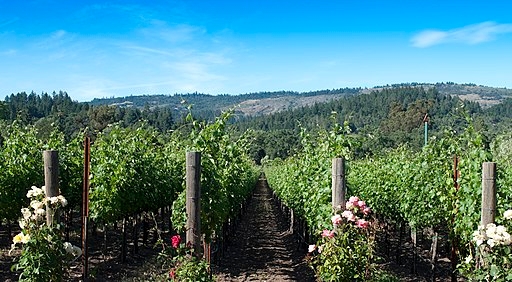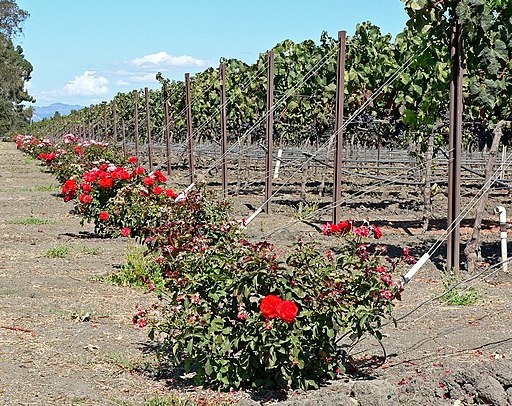A Master Gardener recently visited the Oak Knoll District vineyard of a fellow Master Gardener and saw a rose bush at the head of each row of Cabernet Sauvignon. You may have noticed the same practice in other vineyards in the valley. Roses blooming at the end of vine rows in spring and summer is a sight almost as familiar as the winter mustard bloom.
Why do grape growers do this? Maybe roses and grapes have similar needs for sunlight, fertilizer and water?
In fact, both do like a lot of sunlight, but their water needs differ. Grapevines can have 15-foot taproots; rose roots generally only venture about 3 feet deep. Yes, grapevines have surface roots but growers prefer to force their vines to look for water deeper in the soil to stress them. Stressed vines tend to produce better fruit and, eventually, more complex wine. What's more, watering surface roots encourages weeds and accustoms the vine to high irrigation, not a wise practice in our water-challenged times.
Grapes and roses have different fertilizer needs as well. A basic rose fertilizer is a 4-6-2 formulation, whereas a typical grapevine fertilizer is 16-16-16. These values stand for the percentage of nitrogen, phosphorus and potassium respectively; these nutrients support leaf growth, root health and bloom.
Some say that a rose will show a nutrient deficiency sooner than a grapevine, which may be true, but the deficient nutrients may be different. As the fertilizer formulas indicate, roses appreciate a relatively high percentage of phosphorus.
Also, vines prefer soil with a pH of 5.5 to 6.5, which is slightly acidic. Roses prefer a soil pH closer to 6.5 and won't do well when the pH dips much below that.
Could disease prevention explain the use of roses in vineyards? Roses and grapevines are both susceptible to downy and powdery mildew, and it was long thought that roses would show signs of mildew earlier, alerting the vineyard manager to protect the grapevines. But this isn't the case. The powdery mildew that affects roses (Sphaerotheca pannosa) is a different fungus than the one that affects grapevines (Uncinula necator). These two fungi might show up together because they like similar humidity and temperature, but powdery mildew on a rose is not a reliable indicator of a future fungal outbreak in a vineyard. That said, a sulfur spray works well for both types of fungi.
So maybe roses are planted in vineyards for pest management? Both roses and grapevines are susceptible to the dastardly glassy-winged sharpshooter but in different ways. The insect is a vector for Pierce's disease on the vines but not on the roses. However, the sharpshooter will damage rose leaves, warning the vineyard manager of an infestation before signs of Pierce's disease appear on the vines.
Maybe grape growers relied on rose color to remind them of the grape variety? In the spring, when the vines are just leafing out, it may be hard to remember what's in each vine row or block unless you're an experienced viticulturist. Planting white or red roses at the end of each row could help you recall what is planted there. Could that be the reason?
A final theory about the origins of this co-planting practice is that thorny roses acted like sentries. In the days when vineyards were managed with horse and plow, the horses learned easily that getting too close to the roses could be painful. As a result, they made their turns wide, protecting the last vine and the posts from damage.
So why not add some beautiful roses to your vineyard? Studies show that smelling and viewing roses has calming properties, and the practice of pairing roses and grapevines has historical import in the Napa Valley.
However, this is one tradition you may want to reconsider. Roses need tons of water and fertilizer and are susceptible to many ailments. Label your row posts if you have more than one grape variety, or plant low-maintenance, low-water native species that will remind you of the grapes in each row. Native plants are adapted to our climate, invite beneficial insects and can also be beautiful. And, in lieu of planting cacti, train your horse to make wide U-turns.
Help Desk: The Master Gardener Help Desk is available to answer your garden questions on Mondays and Fridays from 10 a.m. until 1 p.m. Send your questions to mastergardeners@countyofnapa.org. Include your name, address, phone number and a brief description of the problem. For best results, attach a photo of the plant. You may also leave a voicemail message with the same information at 707-253-4143.
Library Talk: UC Master Gardeners will host a talk on “For the Love of Tulips” via Zoom on Thursday, November 3, from 7 pm to 8 pm. Can you successfully grow tulips in an increasingly hot CA weather? What varieties do better than others? Register to receive the Zoom link.
Food Growing Forum: Join UC Master Gardeners of Napa County for a free forum on “Cultivating Mushrooms” on Sunday, November 13, from 3 pm to 4 pm, via Zoom. Register to receive the Zoom link.

